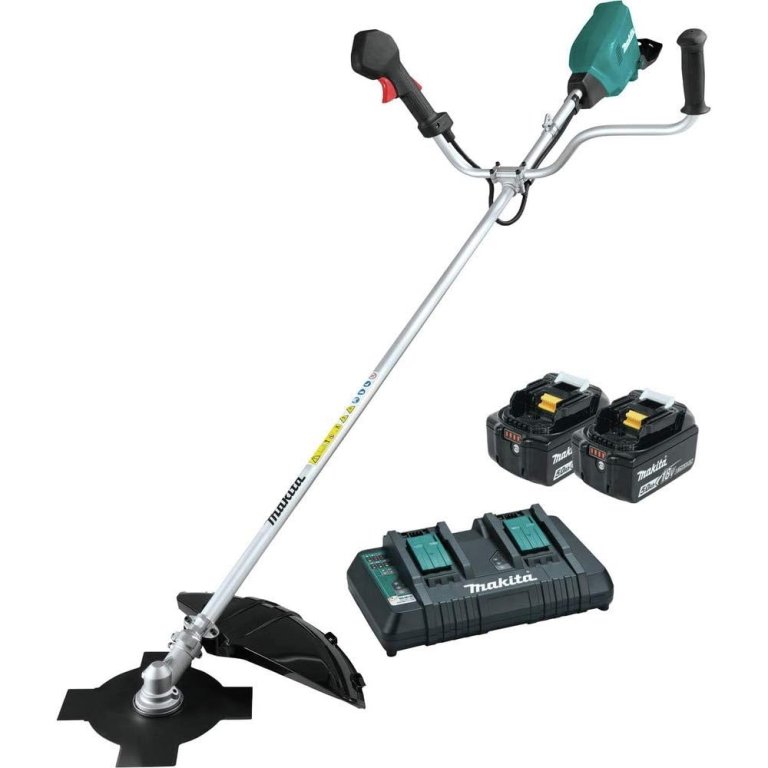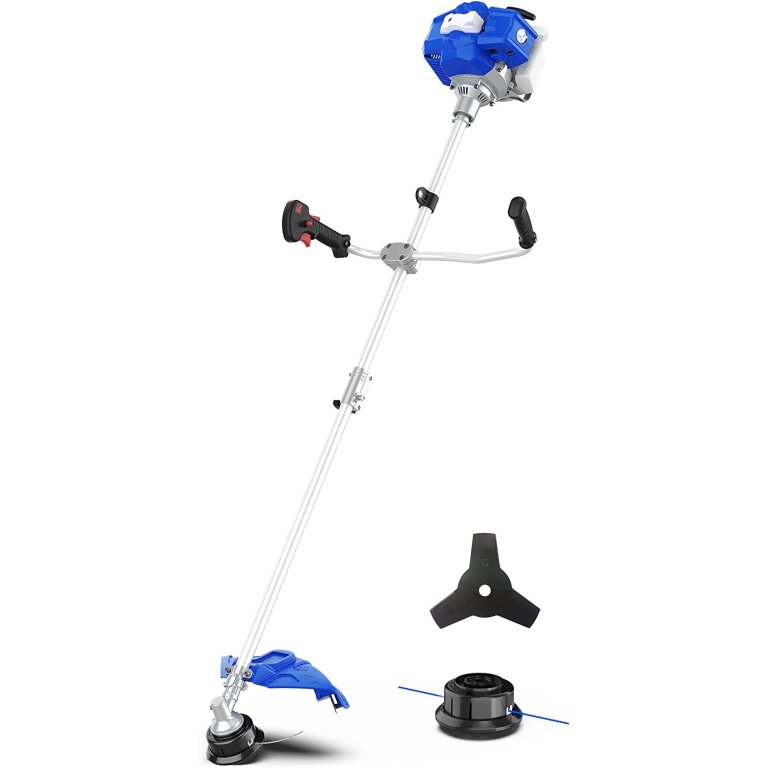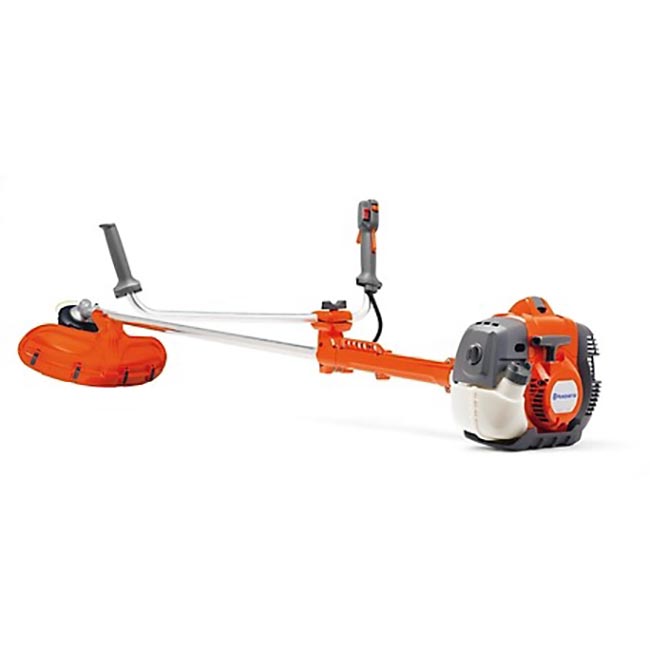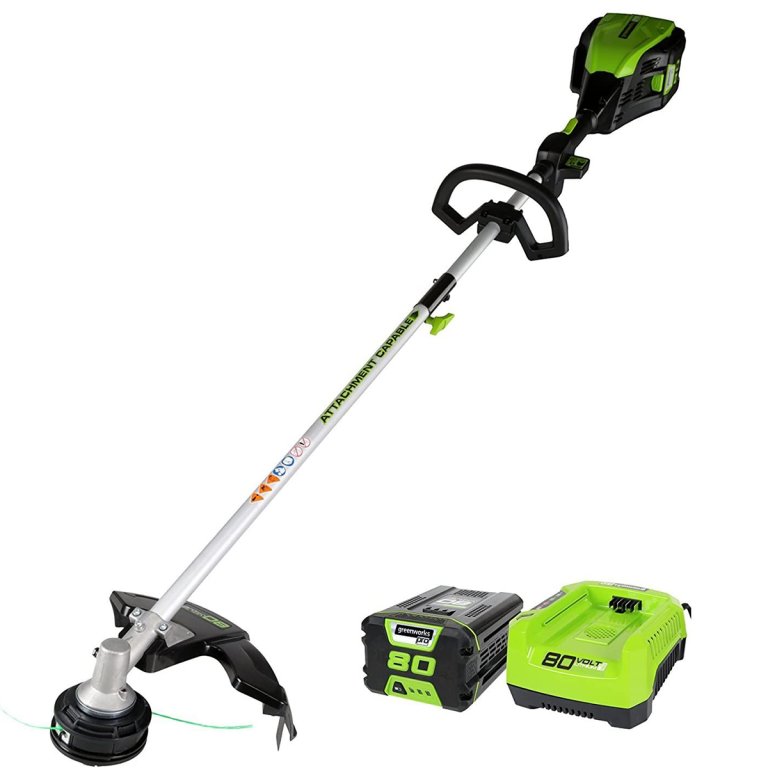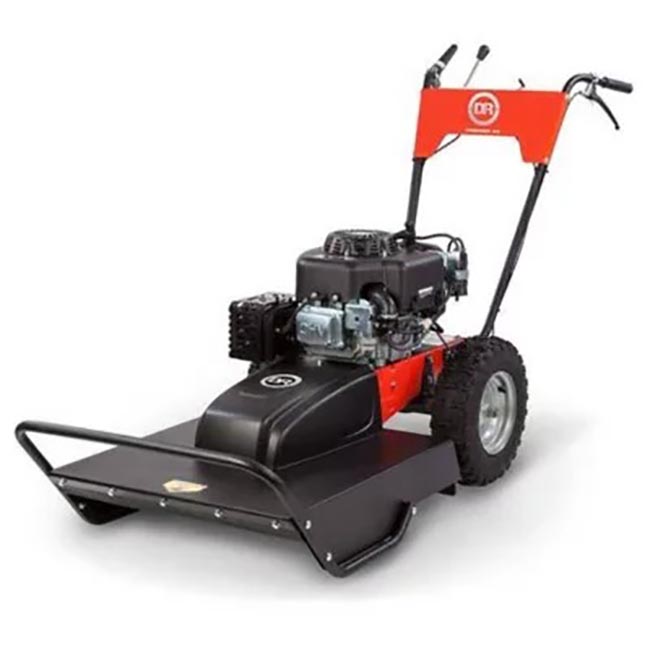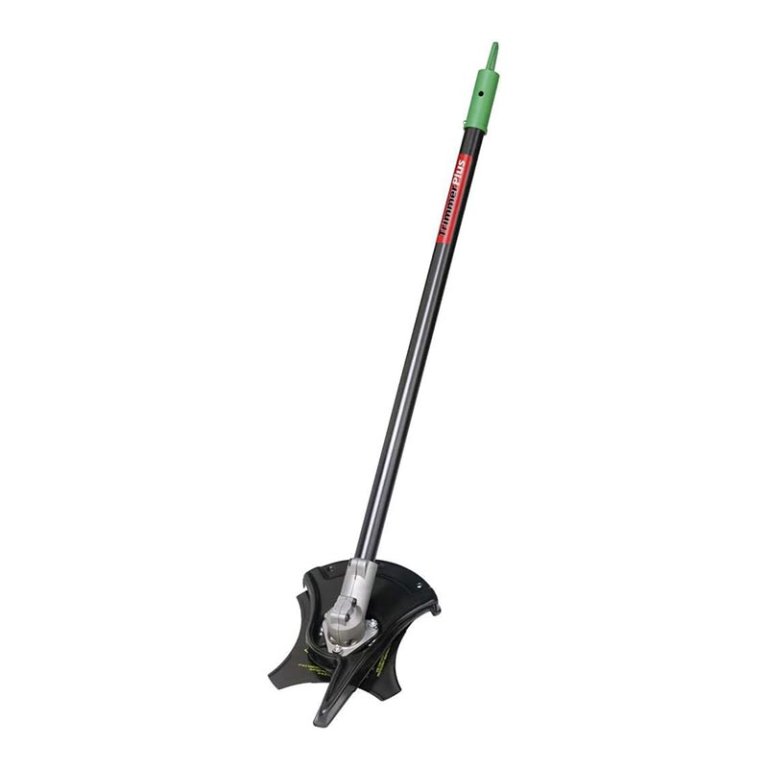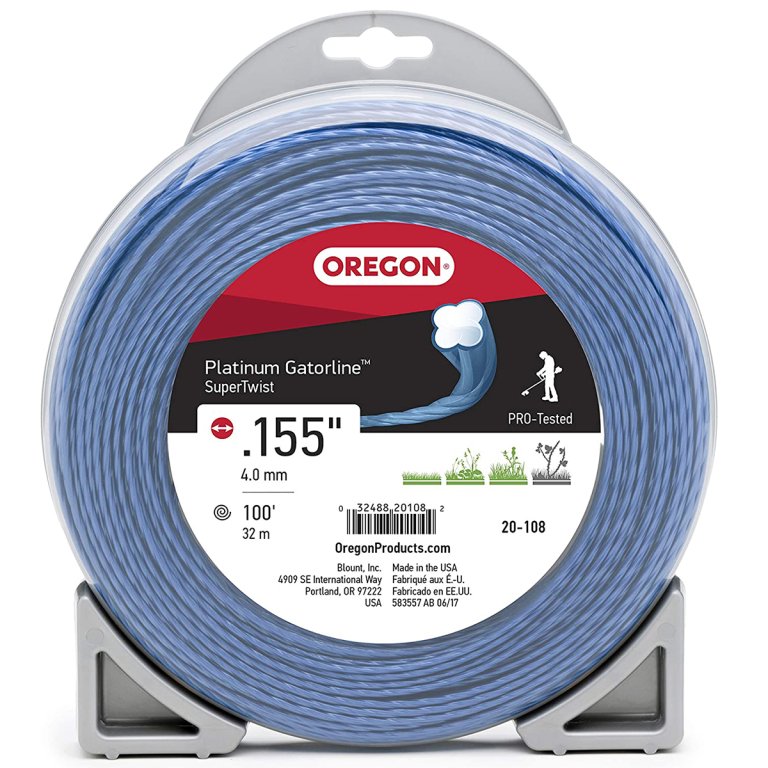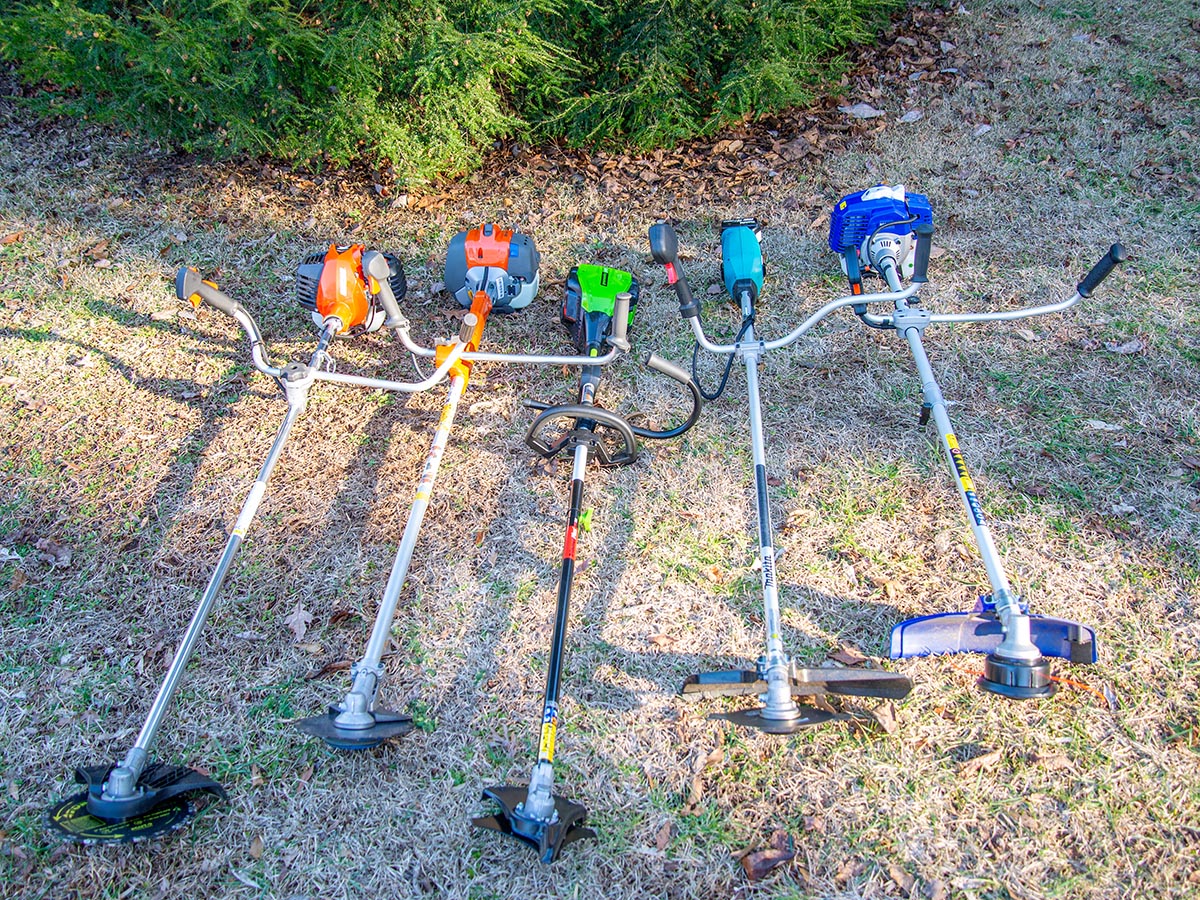
We may earn revenue from the products available on this page and participate in affiliate programs. Learn More ›
Brush cutters can easily grind through overgrown fields, up steep hillsides, and into deep ditches where regular lawn equipment has a hard time performing. When you have lawn care needs that a lawn mower and weed wacker can’t handle, a brush cutter might be the answer.
In my years as a landscaping pro, I used everything from heavy-duty handheld to commercial walk-behind machines I wouldn’t necessarily choose as a homeowner. So for this guide, I whittled down the initial 40 brush cutters of all sizes and types I researched to just nine for testing. After completing five hands-on tests with each option, I chose the Makita 36V LXT Brushless Brush Cutter Kit as the best overall choice for its ease of use, whisper-quiet operation, and effective cutting performance. Whether you’re tackling overgrown grass or tough, woody brush, this roundup of the best brush cutters will have something to fit your needs and budget.
- BEST OVERALL: Makita 36V LXT Brushless Brush Cutter Kit
↓ Jump to Review - BEST BANG FOR THE BUCK: Wild Badger Power 52cc Straight Shaft Brush Cutter
↓ Jump to Review - BEST GAS: Husqvarna 336FR Gas Brush Cutter
↓ Jump to Review - BEST ELECTRIC: Greenworks 80V 16″ Cordless String Trimmer Kit
↓ Jump to Review - BEST WALK-BEHIND: DR Power Equipment Premier 26 Field and Brush Mower
↓ Jump to Review - BEST ATTACHMENT: Troy-Bilt BC720 TrimmerPlus Add-On Brush Cutter
↓ Jump to Review - BEST BLADE: Forester Chainsaw 20-Tooth 9″ Brush Cutter Blade
↓ Jump to Review - BEST STRING: Oregon Platinum Gatorline SuperTwist Trimmer Line
↓ Jump to Review
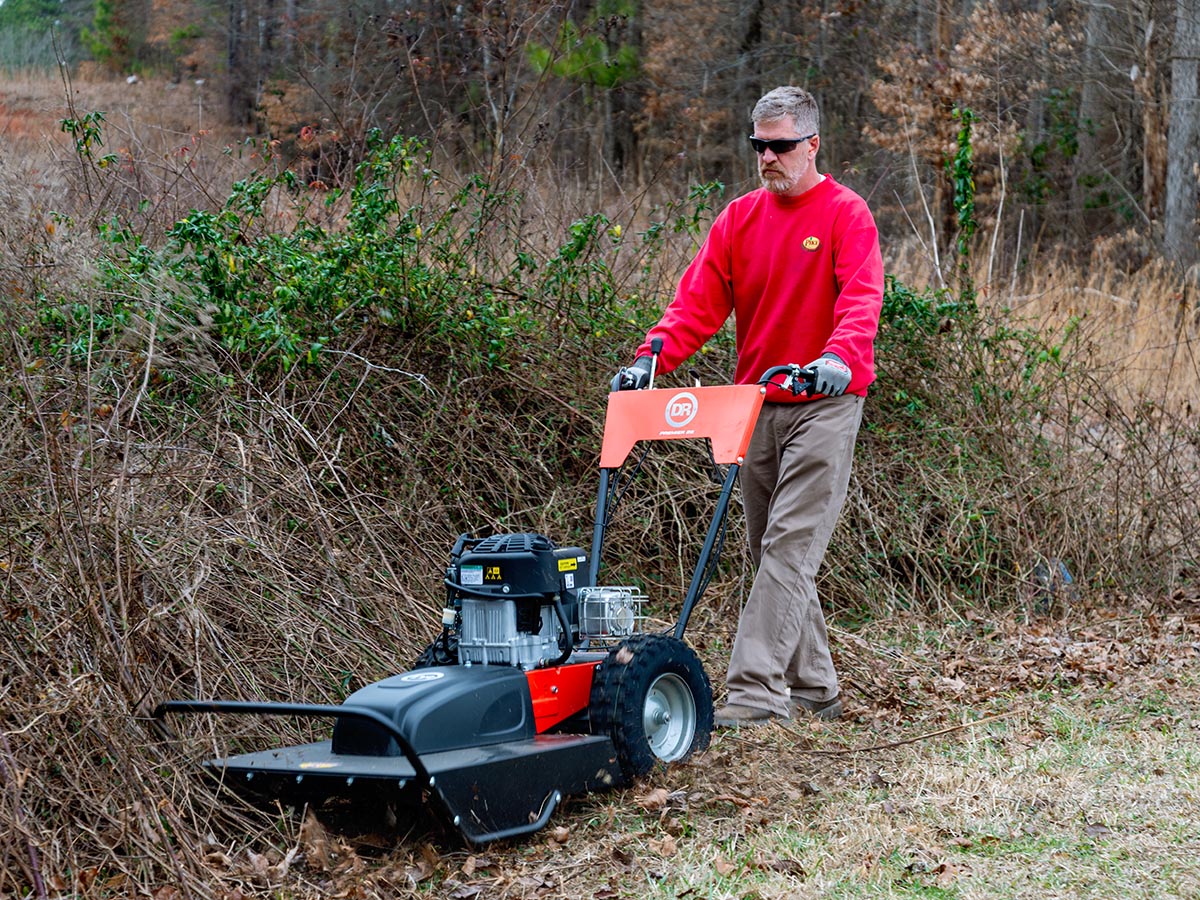
Before You Buy a Brush Cutter
Depending on your needs, a brush cutter could be more tool than is necessary. Brush cutters are heavier, more powerful, and more expensive than typical string trimmers and weed wackers.
If the brush you need to cut isn’t especially dense, it might be more cost-effective to do the job with the tools already in your shed and the help of a new attachment or adapter. However, if the weeds are extra tough, the space is large, and you’ll be trimming everything frequently, it will likely be worth it to invest in a dedicated brush cutter instead.
Brush Cutters Comparison
| Product | Type | Cutting Width | Weight |
|---|---|---|---|
| Makita 36V LXT Brushless Brush Cutter Kit | Handheld | 9 inches | 16.8 pounds |
| Wild Badger Power 52cc Straight Shaft Brush Cutter | String trimmer conversion | Up to 18 inches | 19.5 pounds |
| Husqvarna 336FR Gas Brush Cutter | Handheld | 18 inches (string) or 9 inches (blade) | 18 pounds |
| Greenworks 80V 16″ Cordless String Trimmer Kit | Handheld | 16 inches | 11 pounds |
| DR Power Equipment Premier 26 Field and Brush Mower | Walk-behind | 26 inches | 237 pounds |
| Troy-Bilt BC720 TrimmerPlus Add-On Brush Cutter | Cutter attachment | 8 inches | 2 pounds |
| Forester Chainsaw 20-Tooth 9″ Brush Cutter Blade | Cutting blade | 9 inches | 1 pound |
| Oregon Platinum Gatorline SuperTwist Trimmer Line | String trimmer string | Adjustable | 1 pound |
Our Top Picks
The best brush cutters can make quick work of tidying overgrown corners, but with so many options on the market, it can be difficult to choose the best model for your specific job. Read on to find out how each of these picks performed in hands-on testing so you can decide which brush cutter is best for your cleanup project.
Best Overall
Photo: AmazonWhat We Like
- Eco-friendly; doesn’t use gas or produce emissions
- Molded grips, brushless motor, and variable-speed trigger
- Steel drive shaft minimizes handle vibration
- Backpack-style harness minimizes user fatigue
What We Didn’t Like
- 30-minute runtime is on the short side
- Expense might not be worth it for limited use
Product Specs
- Type: Handheld
- Cutting width: 9 inches
- Weight: 16.8 pounds
This Bob Vila Approved product carries our brand’s highest level of recommendation.

Bob Vila Approved recognizes the household and DIY products that impressed us most in our real-world testing and that exemplify core values of the Bob Vila brand, including craftsmanship, innovation, and value for the dollar. Winners of this designation come recommended by our professional review team and are personally approved by Bob Vila.
Our Ratings: Ease of Use 4.7/5; Noise 5/5; Effectiveness 4.3/5; Durability 4/5; Value 4.5/5
Powered by two rechargeable batteries, the Makita 36-volt LXT cordless brush cutter features bicycle-style handlebars, an efficient brushless motor, a 9-inch steel-blade cutting head, and Automatic Torque Drive Technology to adapt to heavy brush. Weighing just 16.8 pounds with batteries and blade, it’s light and easy to handle. The steel drive shaft produces low vibration, and the well-padded and adjustable harness system was the most comfortable of all the models we tested.
We named this Makita battery-powered brush cutter Best Overall for its efficiency, easy operation, and comfort. In testing, the batteries provided 30 minutes of nonstop cutting per charge through coarse grass, vines, brambles, shrubs, and tree seedlings up to 0.75 inches thick. The included 4-tooth circular steel blade held its edge perfectly, even after a few encounters with unseen rocks, and powered through a wider variety of materials than both heavy-duty trimmer string and sawtooth blades. The low speed setting was perfect for woody brush, and the higher speeds cut quickly through coarse weeds and brambles. While the 30-minute runtime was more than I expected, it still might be a limitation for large properties. For general-purpose cutting in a wide range of conditions, though, this is an outstanding choice.
What our tester says: “The harness fit like a super comfortable backpack, and combined with the tool’s low weight, brush cutting with this model was easier than with any of the others.”—Mark Wolfe, Product Reviews tester and writer
Read our full review: Makita 36V LXT Brushless Brush Cutter Kit
Get the Makita brush cutter at Amazon or The Home Depot.
Best Bang for the Buck
Photo: AmazonWhat We Like
- 52 cubic centimeter (cc) 2-cycle engine delivers ample power
- Blade adapter fits other rigid brush-cutting blades
- Includes both 3-tooth brush cutter head and string trimmer head
- Bicycle-style handlebars and harness increase control and comfort
What We Didn’t Like
- Heavier, louder, and harder to start than others
- Less efficient and durable than higher-end models
Product Specs
- Type: String trimmer conversion
- Cutting width: Up to 18 inches
- Weight: 19.5 pounds
Our Ratings: Ease of Use 4/5; Noise 4/5; Effectiveness 4.3/5; Durability 4/5; Value 4.5/5
If budget is a primary concern, we know of no better option than the Wild Badger Power string trimmer brush cutter. It does double duty as a brush cutter and a string trimmer, making it versatile for both fine trimming and heavier brush work. Weighing 19 pounds, it includes a harness and bicycle-style handlebars for added stability and control. It features a 52cc 2-cycle full-crank engine for taking on projects of all sizes, and the straight aluminum shaft helps reduce fatigue during long periods of use.
While it offers solid cutting performance at a low price, the Wild Badger lacks the comfort and refinement of pricier models. It was the heaviest handheld cutter we tested, and the included shoulder and waist straps were a bit flimsy and lacked padding. Assembly was easy and only took a few minutes, but startup took five to seven pulls every time. While the big engine was a bit louder than others, the actual cutting power seemed about the same or only slightly lower than the Husqvarna model reviewed below. The string trimmer head worked well on overgrown grass and coarse weeds, and the 3-tooth steel blade was good for brambles and vines. Neither did a great job on seedlings and weedy shrubs thicker than half an inch in diameter, but it can support a sawtooth brush blade if you need that capability.
Get the Wild Badger Power brush cutter at Amazon or Walmart.
Best Gas
Photo: Tractor SupplyWhat We Like
- 34.6cc engine produces ample torque and blade speed
- Includes a string trimmer head plus 3- and 22-tooth blades
- Easy to start and low vibration
- Well-padded and easy-to-adjust backpack harness
What We Didn’t Like
- Brush blade assembly limits depth of cut to 2 inches
- Unclear instructions for assembling the rigid blades
Product Specs
- Type: Handheld
- Cutting width: 18 inches (string) or 9 inches (blade)
- Weight: 18 pounds
Our Ratings: Ease of Use 4.5/5; Noise 5/5; Effectiveness 4.5/5; Durability 5/5; Value 4.5/5
The Husqvarna 336FR brush cutter with blade is great for those who need a powerful, versatile, and dependable gas brush cutter. It packs an easy-to-start 34.6cc engine, bicycle-style handlebars, a well-padded backpack-style harness system, and three interchangeable cutting heads: a string trimmer, a 3-tooth grass blade, and a 9-inch brush blade.
Assembly was mostly straightforward. The printed directions for the handlebar and string trimmer head were perfectly clear, but I had to resort to an internet search when it came time to change over to a rigid blade. It turned out I needed to install a different blade guard in order to work with the brush saw, but at least all the necessary parts were included. Once I had everything set up, I discovered the rigid blades worked best for grass and thin-to-moderate woody stems since the donut-shaped fitting between the blade and the nut restricted cutting depth to about 2 inches. Also, the donut is made of plastic, and it showed signs of wear after an hour of cutting.
The brush blade, however, was outstanding. With its relatively thin kerf and 22 chisel teeth, it buzzed through woody stems like a warm knife through butter. The special blade guard allowed more of the blade to be exposed, which was convenient for moving through dense stands of brush. The potential downside of the smaller guard was flying debris, so I wore a forestry-style hard hat with earmuffs and a mesh face shield in addition to safety glasses. The motor didn’t bog down at all, even when cutting hardened, dry wood, and I always felt in control with the handlebars. Also, the harness system was as comfortable and easy to adjust as our Best Overall pick, the Makita.
Get the Husqvarna brush cutter at Lowe’s or Tractor Supply Co.
Best Electric
Photo: AmazonWhat We Like
- Efficient brushless electric motor; up to 45 minutes of battery life
- Variable-speed trigger and lightweight construction
- Comes with a battery and rapid charger included
- Battery and charger included; rapid charging
What We Didn’t Like
- Brush cutter attachment is not included with purchase
- Underpowered for clearing tree seedlings and thick, woody brush
Product Specs
- Type: Handheld
- Cutting width: 16 inches
- Weight: 11 pounds
Our Ratings: Ease of Use 5/5; Noise 3.7/5; Effectiveness 4.5/5; Durability 4/5; Value 4.5/5
The attachment-capable Greenworks 80-volt powerhead with string trimmer attachment is a good investment for those with small properties and limited storage space. It eliminates the need for fuel handling and gas engine maintenance, and it works just as well with daily use as it does after months in storage. Its affordability, adaptability, ease of operation, and impressive battery life earned it a spot on this list, but it’s important to note you’ll need to purchase a compatible brush blade separately.
The 80-volt 2.0 Ah (amp hour) battery delivered 15 to 20 minutes of runtime per charge, with one charge handling trimming and the second accommodating light brush cutting. While this would not be enough for big yards, it was plenty for a few thousand square feet (and recharging only takes about 30 minutes). In its base configuration, the electric motor provided just enough power to take out the occasional tree seedling or vine that found its way into my border plantings. When equipped with a brush cutter attachment (like the Troy-Bilt brush cutter attachment reviewed below), it easily tackled thicker vines, blackberry canes, and woody brush up to half an inch in diameter.
Although the included diagonal shoulder strap wasn’t as supportive as a full harness, it was still fairly comfortable thanks to the light weight of the machine. The variable-speed trigger worked smoothly, and the cutter produced very little vibration during operation. If you need a reliable, user-friendly option for light-duty work across multiple tasks, this battery string trimmer will be great.
Get the Greenworks brush cutter at Amazon or Greenworks.
Best Walk-Behind
DR Power Equipment Premier 26 Field and Brush Mower
Buy at Northern Tool + Equipment Buy at DR PowerWhat We Like
- Heavy-duty engine and large mowing deck
- User-friendly self-propelled system
- Large, knobby, air-filled tires provide excellent traction
- Floating deck glides through weeds and brush up to 2 inches thick
What We Didn’t Like
- Takes up more storage space than a handheld unit
- Delivered via tractor-trailer, which could be problematic for some
Product Specs
- Type: Walk-behind
- Cutting width: 26 inches
- Weight: 237 pounds
Our Ratings: Ease of Use 4.3/5; Noise 4/5; Effectiveness 4.7/5; Durability 5/5; Value 4.5/5
For larger, more frequent brush-cutting tasks like trail clearing or rough mowing, a walk-behind brush cutter is often the best choice. This model from DR Power is one of the lightest available, yet it still has a 10.5 horsepower gas engine and a 26-inch brush deck for handling materials up to 2 inches thick. Large, sealant-filled tubeless lugged tires and a 4-speed geared transmission (three forward, one reverse) make it surprisingly easy to maneuver, even over rutted, uneven ground. The three-sided cutting deck ensures that clippings are well mulched, leaving behind a nice, neat appearance with no windrows.
Our DR Power Premier heavy-duty brush cutter shipped directly from the factory and was delivered on the back of a tractor-trailer with a lift gate. Assembly was easy, I just had to pull off the packing material, attach the handlebar, and secure the throttle and clutch cables. After adding oil and gas, the engine started on the third pull. I mowed nearly half an acre of overgrown brush on a deeply rutted powerline right-of-way, including 7-foot blackberry thickets and tree saplings up to 1.5 inches thick.
As I mowed in first and second gears, the floating deck glided smoothly over everything without becoming entangled in the debris, while the weight of the machine gave the wheels excellent traction. The blade did not bog down, cutting went quite quickly, and the finished results were better looking than simply “knocking down” the brush with a handheld brush cutter. Just bear in mind that this big outdoor power tool requires a lot more storage space, and you’ll need a pickup truck and landscape trailer to move from job to job.
What our tester says: “This machine tore through thick brush like it was nothing. It felt powerful, smooth, and way faster than using a handheld cutter.”—Mark Wolfe, Product Reviews tester and writer
Get the DR Power brush cutter at Northern Tool + Equipment or DR Power.
Best Attachment
Photo: AmazonWhat We Like
- Fits most attachment-capable gas and electric powerheads
- 4-tip steel blade cuts tough vines, thick brush, and coarse weeds
- Shoulder strap limits back and arm strain
- J-bar handle and adapter increase user control
What We Didn’t Like
- Brush cutter blades are loud during use
Product Specs
- Type: Cutter attachment
- Cutting width: 8 inches
- Weight: 2 pounds
Our Ratings: Ease of Use 5/5; Noise 4/5; Effectiveness 4.5/5; Durability 4/5; Value 4.5/5
The Troy-Bilt TrimmerPlus brush cutter is a universal attachment compatible with most gas and cordless electric powerheads. It features a 1.65-inch inner coupler tube and a 0.20-inch square drive-shaft connector, fitting most attachment-capable models. Though it’s only an attachment, the purchase includes a shoulder strap and a J-bar handle for added control and comfort.
This attachment brush cutter for a weed eater is highly durable, easy to install, and a good value. I tested it with the above Greenworks trimmer, and the shaft clicked securely into the powerhead shaft using a spring button, while the J-bar handle mounted easily with four screws. Since the powerhead came with a shoulder strap, I didn’t need to install the one included with the brush cutter.
Though the Troy-Bilt brush cutter attachment is such a lightweight tool, it worked extremely well for cutting through coarse weeds, tough vines, and woody brush up to 0.5-inch in diameter. Despite the blades not feeling especially sharp, the torque and speed delivered clean, effective cuts, and the brush guard helped protect against flying debris. The only thing I didn’t like was the high-pitched noise that it made, which may not have been noticeable with a gas powerhead. Just be sure you check your powerhead owner’s manual to ensure attachment compatibility.
Get the Troy-Bilt brush cutter at Amazon or Northern Tool + Equipment.
Best Blade
Photo: AmazonWhat We Like
- Suitable for thick, woody brush
- Includes a 0.1875-inch round file for sharpening
- 1-inch arbor and 20-millimeter bushing to fit most brush cutters
- Durable carbide construction can last for years
What We Didn’t Like
- Hitting hard surfaces may damage the cutting teeth
Product Specs
- Type: Cutting blade
- Cutting width: 9 inches
- Weight: 1 pound
Our Ratings: Ease of Use 4.3/5; Noise 5/5; Effectiveness 4.5/5; Durability 5/5; Value 5/5
The Forester 9-inch brush blade functions like a rotary chainsaw, transforming a standard string trimmer into a powerful tool for clearing woody brush and coarse weeds. Designed to handle dense undergrowth and saplings up to 2 inches thick, it’s a fast and effective upgrade for heavy-duty trimming. The package also includes a file to help keep the blade’s 20 steel cutting teeth sharp.
This brush-cutter blade is durable, budget-friendly, and easy to install. The manufacturer recommends pairing it with brush cutters equipped with 30cc engines or larger, and with a maximum engine speed of 10,000 RPM. I tested it with an Echo brush cutter, and it worked perfectly using that mode’s blade adapter—no need for the 20-millimeter bushing. The blade felt well balanced and cut aggressively through brush up to 3 inches thick. It stayed impressively sharp, even after hitting a few hidden rocks.
While the blade was less effective in areas dominated by weedy grass, it excelled where shrubs and saplings were thick. For tough overgrowth, it was by far the best-performing brush blade in the bunch. As with other attachments, remember to consult your trimmer’s manual to confirm compatibility before purchasing.
Get the Forester brush cutter blade at Amazon or Forester.
Best String
Oregon Platinum Gatorline SuperTwist Trimmer Line
Buy at Amazon Buy at The Home Depot Buy at WalmartWhat We Like
- Twisted string can cut through thicker weeds and brush
- Heavy-duty wind- and abrasion-resistant construction
- Special noise-reducing design minimizes noise pollution
What We Didn’t Like
- Should be used with 35cc trimmers or larger
Product Specs
- Type: String trimmer string
- Cutting width: Adjustable
- Weight: 1 pound
Our Ratings: Ease of Use 4.5/5; Noise 5/5; Effectiveness 4.5/5; Durability 5/5; Value 4.5/5
Heavy-duty trimmer line is a reliable alternative to steel blades, especially since it won’t spark when hitting rocks. Oregon’s Platinum Gatorline SuperTwist trimmer line features a twisted profile for maximum cutting-edge exposure, low noise, and excellent durability. Its hard exterior holds up well to high temperatures and impacts, making it great for cutting tough and brushy material, such as overgrown weeds, vines, brambles, and tree seedlings.
The 0.155-inch trimmer line I tested pairs best with brush cutters equipped with engines over 35cc and requires a large trimmer head designed for thick line. I used it with an older Stihl brush cutter, but it’s also available in 0.080-, 0.095-, and 0.105-inch diameters, so it’s compatible with medium-duty string trimmers and brush cutters. When powered by the 37cc engine of my Stihl model, this Gatorline easily cut down fibrous, weedy material and woody stems up to half an inch in diameter. Its thickness and rigidity simplified loading trimmer heads that use precut lengths of fixed line, but those features also made it a bit hard to wind onto a bump head. Still, this thick trimmer line holds up so well in tough conditions that you’ll likely be making fewer stops to reload.
Get the Oregon brush cutter trimmer line at Amazon, The Home Depot, Walmart, or Northern Tool + Equipment.
Jump to Our Top Picks
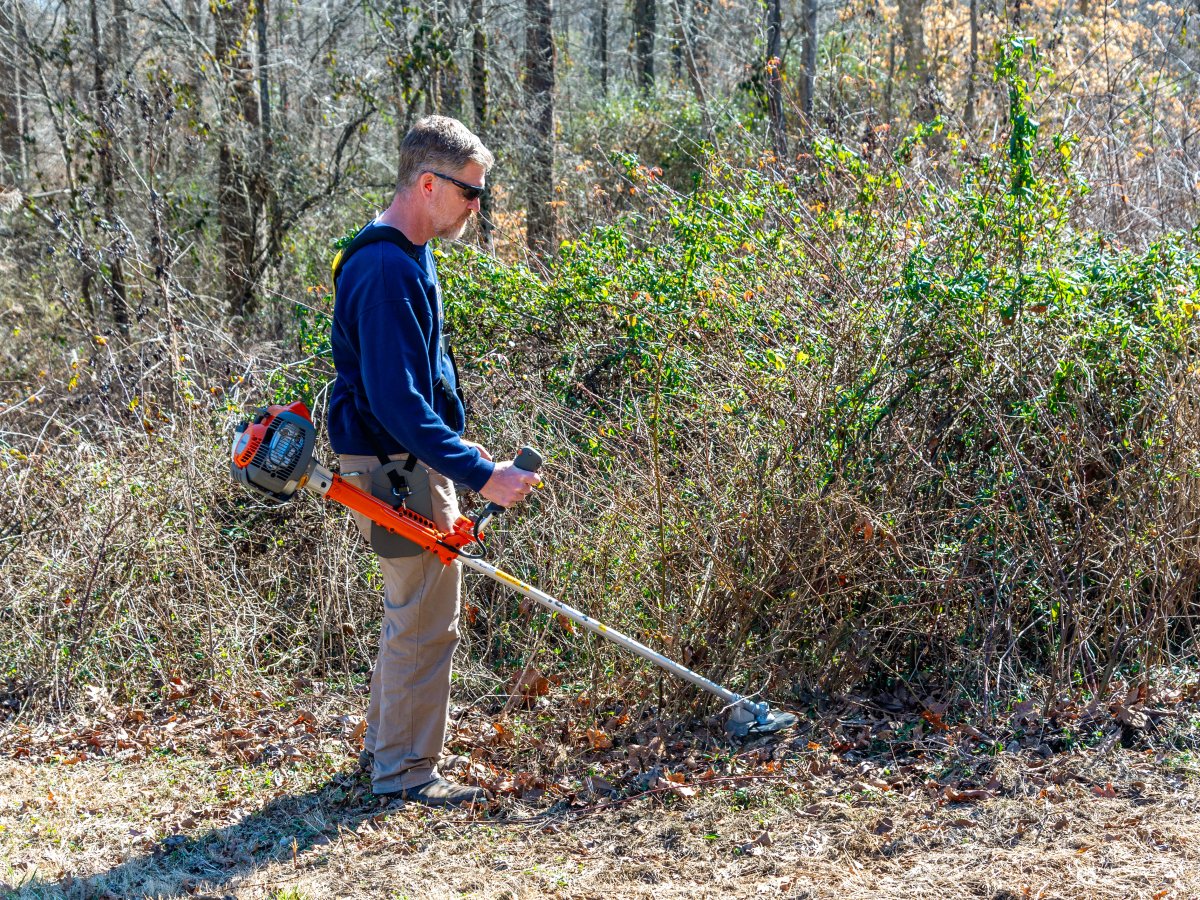
How We Tested the Best Brush Cutters
| Products tested | 9 |
| Time spent testing | 11 hours |
| Tests performed | 5 |
| Price range | $20 to $200 |
After researching more than 40 different brush-cutting tools, I settled on nine options for testing. These include a heavy-duty walk-behind model, several gas- and battery-powered handheld brush cutters, and an assortment of string trimmer attachments. I tested the walk-behind and handheld machines using all the equipment they came with. This included fixed blades, string trimmers, and for some, a heavy-duty trimmer line. I used Greenworks’ attachment-capable trimmer to test the universal brush-cutter attachment.
Each test was performed on 1,000 square feet of coarse, grassy lawn weeds, followed by another 1,000 square feet of woody brush. Afterward, I recorded my observations, beginning with the assembly process, then starting the machine, operating it, and performing the required maintenance. I scored all products on a rubric before giving each an award to highlight its standout features.
| Product | Ease of Use | Noise | Effectiveness | Durability | Value |
| Makita 36V LXT Brushless Brush Cutter Kit | 4.7 | 5 | 4.3 | 4 | 4.5 |
| Wild Badger Power 52cc Straight Shaft Brush Cutter | 4 | 4 | 4.3 | 4 | 4.5 |
| Husqvarna 336FR Gas Brush Cutter | 4.5 | 5 | 4.5 | 5 | 4.5 |
| Greenworks 80V 16″ Cordless String Trimmer Kit | 5 | 3.7 | 4.5 | 4 | 4.5 |
| DR Power Equipment Premier 26 Field and Brush Mower | 4.3 | 4 | 4.7 | 5 | 4.5 |
| Troy-Bilt BC720 TrimmerPlus Add-On Brush Cutter | 5 | 4 | 4.5 | 4 | 4.5 |
| Forester Chainsaw 20-Tooth 9″ Brush Cutter Blade | 4.3 | 5 | 4.5 | 5 | 5 |
| Oregon Platinum Gatorline SuperTwist Trimmer Line | 4.5 | 5 | 4.5 | 5 | 4.5 |
What to Look for When Choosing a Brush Cutter
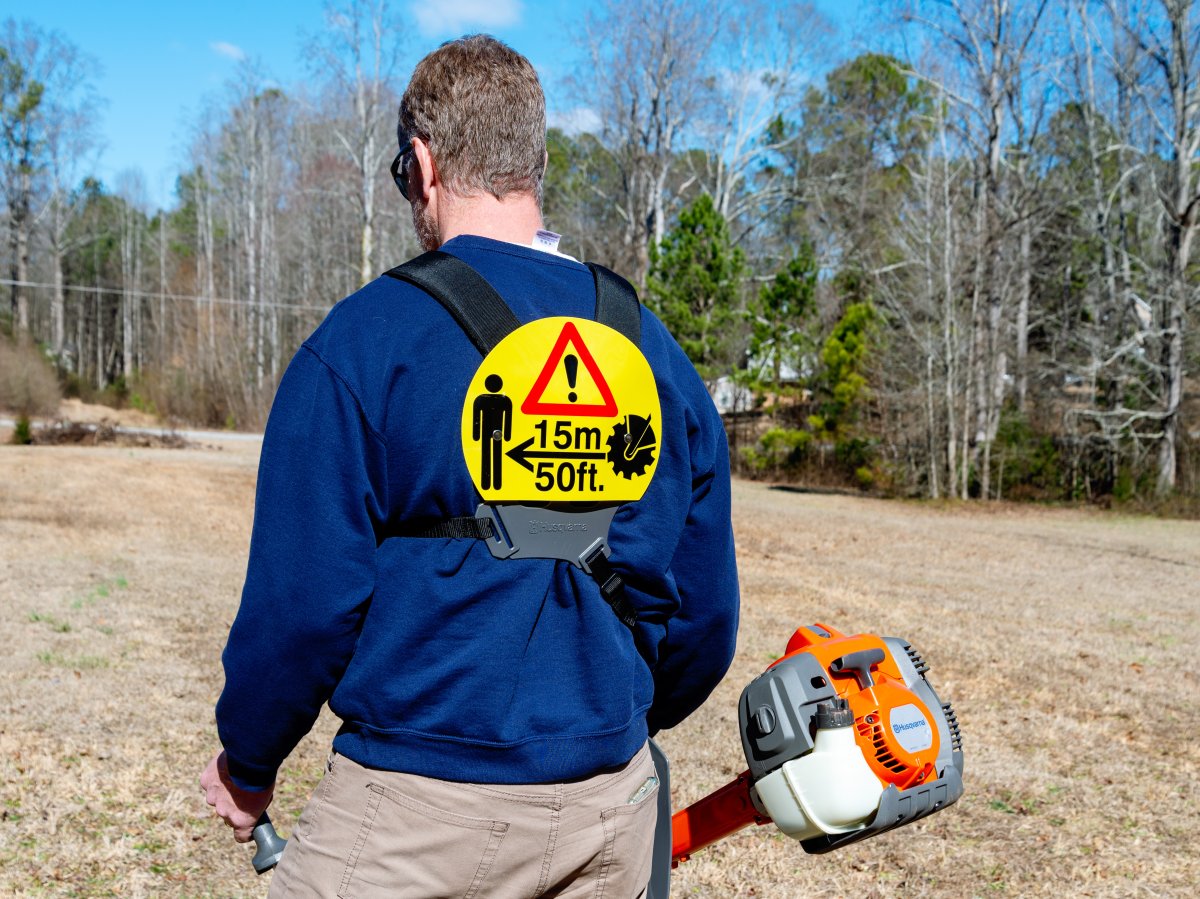
There are several factors to consider while shopping for a brush cutter. Cutting thick vines and woody brush requires more power than mowing tall grass, so you’ll need a cutter with some muscle. If you’re shopping for handheld models, you can go with a powerful cordless electric model or a long-lasting gas-powered model. Ahead, learn about the factors that should drive buying decisions.
Types of Brush Cutters
Buying a brush cutter machine is a long-term investment, so it’s important to choose wisely. A high-quality tool should last for years, but it’s just as crucial to select the right type of tool for your property. A machine that’s too small will waste your time, while one that’s too large will waste money and storage space. Read on to learn about the different kinds of brush cutters and how they work.
Converted String Trimmer
For occasional brush cutting, consider converting your string trimmer into a brush cutter rather than buying a whole new machine. Most gas-powered string trimmers have 20cc to 30cc engines, which are adequate for occasional heavy-duty use, such as cutting brush for a few hours once a month. More frequent use may require a dedicated machine.
Some powerheads (the part of a trimmer that houses the engine, connecting to the drive shaft and transmitting power to the cutting head) are compatible with different attachments. These typically feature a short drive shaft and a quick-connect system for easy attachment changes. If you own this type of powerhead, buying a brush-cutting attachment may be a smarter investment than purchasing a separate brush cutter. In fact, string trimmer and brush cutter heads are just two of many attachments these systems can support.
Converting a fixed-shaft string trimmer into a brush cutter takes a little longer and requires a brand-specific adapter. With basic hand tools, it typically takes about 5 minutes to remove a trimmer head and install a brush-cutting head.
There are four basic types of brush-cutting heads:
- Knife blades are the most common. They use a sharpened front edge to slice through weeds. Choose knife blades—either a disc knife or tri knife—for general-purpose brush cutting, as they are inexpensive and durable.
- Chisel knives are smaller and more aggressive than knife blades. These include the circular saw and chainsaw types. They work very well on heavier brush and small saplings but require larger engines—around 30cc and bigger—to work efficiently.
- Smasher blades, also called flails, use thin edges and high velocity to smash through vegetation. This category includes extra-thick trimmer lines, from 0.095 to 0.155 inches in diameter or larger. These are not suitable for heavy, woody material, but they work quite well on tall, weedy grass.
- Mulching blades look like knife blades, but the blade tips bend at a nearly 90-degree angle. These blades are relatively uncommon and best for grinding up weeds, leaves, and branches.
Handheld
If you care for a large suburban or rural property, a handheld brush cutter might be just what you need to take down heavy weeds and areas of thick brush that are hard to access with a mower. A handheld brush cutter looks like a string trimmer, only it uses a specialized brush-cutting head and normally comes with a more powerful engine. As mentioned earlier, it is possible to retrofit a string trimmer with a brush-cutting head for occasional use.
Brush-cutting heads use heavy-duty trimmer string, rigid flails, or a circular saw-type blade to cut through woody material quickly and efficiently. Handheld electric brush cutters and gas brush cutters with engines smaller than 40cc work well for smaller jobs, like maintaining a weedy ditch or cleaning up a vegetable garden at the end of the season. For larger areas that demand more muscular cutting capabilities, choose a gas-powered brush cutter with an engine larger than 40cc. These heavy-duty models can cut through saplings up to 2 inches thick.
Walk-Behind
Hobby farmers and other small-acreage owners typically choose walk-behind brush cutters to maintain trails, fields, and pastures up to 1 acre. Sometimes called rough-cut mowers, walk-behind brush cutters use heavy-duty rotary mower blades. These machines can cut down coarse weeds, tall grass, and weedy shrubs. Some can cut down saplings 2 inches in diameter or larger.
Walk-behind brush cutters are single-purpose machines, but brush-cutter attachments are available for walk-behind tractors. Some lightweight models are essentially string trimmers on wheels, but most walk-behind models are much more robust, featuring heavy-gauge metal components that help them grind through dense, weedy thickets. They are self-propelled with rear-mounted engines and large pneumatic tires. This design allows the forward mower deck to easily glide through tall vegetation.
Tow-Behind
Farmers and managers of large-acreage properties choose tow-behind brush cutters for long trails, large fields, wildlife food plots, roadside areas, and utility rights-of-way. Tow-behind brush cutters, also known as brush hogs, are large rotary mowers that users pull behind tractors or ATVs.
Some tow-behind brush cutters have their own engine that engages the blade while you drive over the area to cut. Other tow-behind models need the tow vehicle to supply the power. They connect to the towing vehicle’s power take-off (PTO) by a drive shaft that turns the mower blade.
Gas vs. Electric
Handheld brush cutters use either gas or battery electric power. Gas brush cutters provide plenty of power and extended cutting time. Electric brush cutters operate quietly, keep the air clean, and eliminate the cost and hassle associated with purchasing, handling, and storing liquid fuel.
Electric brush cutters work great for mowing down an overgrown vegetable garden at season’s end or maintaining small natural areas you don’t mow regularly. Electric power is an especially good choice if you only need to use the tool a few times a year because it eliminates the worry over stored fuel going bad, though power and battery life limit the usefulness of an electric brush cutter on a larger property.
Although there are a few 4-cycle models on the market, most handheld models feature 2-cycle engines that require mixed fuel (2-cycle oil mixed into the gasoline). That adds a layer of preparation time and expense. While 4-cycle alternatives are heavier and can cause more user fatigue, they offer more power and reduced exhaust emissions.
Motor Power
Power translates directly to working ability: A more powerful brush cutter will cut faster and more smoothly than its less powerful competitor. Increased power helps in adverse conditions, such as when mowing through thicker weeds and brush or uneven terrain. When all else is equal, the more powerful machine is more capable.
Cordless electric brush cutters measure power in volts and are typically rated between 18 and 84 volts. Gas-powered engines are measured in cubic centimeters of displacement. Handheld brush cutters range from 24cc to 50cc. Handheld brush cutters with power over 56 volts or 35cc are considered heavy duty.
Walk-behind brush cutters and tow-behind cutters with their own engines normally list the engine size in horsepower, although some manufacturers may show it in cc. There are approximately 14cc per 1 horsepower. You can easily convert cc to horsepower for an equal comparison (cc/15 = horsepower), though the ratio can vary across different engine manufacturers. Many walk-behinds produce between 10 and 20 horsepower.
Tow-behind brush cutters that run via PTO need enough horsepower to run efficiently. Consult the tractor or ATV manufacturer’s information to learn how much horsepower a PTO supplies. The rule of thumb is that for every foot of cutter width, the PTO must supply 5 horsepower. A 5-foot brush cutter needs about 25 horsepower from the PTO.
Cutting Width
Cutting width measures the width of a single pass with a brush cutter. It determines both how quickly a cutter can complete the work and how much space the machine requires for access to the site. Handhelds range from 9 to 18 inches, walk-behinds are 24 to 26 inches, and tow-behind cutters range from 4 to 15 feet.
Wider cutters use more power and can more easily bog down in dense vegetation. On the other hand, narrow cutters get the job done more slowly. Tow-behind brush cutters should cut wider than the width of the tractor; otherwise, the tractor will drive over some vegetation twice before the mower passes over it. Also, consider the width of narrow access points that the machine must pass, such as gates or nearby trees.
Durability
Walk-behind and tow-behind brush cutters come with heavy-gauge steel housings, rugged pneumatic tires, and powerful engines that hold up in rough working conditions. Handheld brush cutters vary greatly, running the gamut from light-duty string trimmers to powerful brush-cutting machines. For optimal durability, use these machines to do the tasks for which they are best suited.
When converted with brush-cutting heads, gas string trimmers with engines between 24cc and 35cc are adequate for limited use on thick grass and tall weeds. Heavy-duty string trimmers with larger engines can be converted to cut thick weeds, woody vines, and small saplings. True handheld brush cutters, with powerful 40cc to 50cc engines, can extend to cutting thick, dense, woody vegetation.
Versatility
Multifunctional tools often present greater value than single-purpose ones. For instance, despite their specialized design, most owners only use handheld and walk-behind brush cutters a few times a year. For more versatility, consider buying brush-cutter attachments compatible with machines that perform other lawn care tasks.
The benefit of converting a string trimmer to a brush cutter by changing the head is that the extra head takes up virtually no storage space and extends the usefulness of existing equipment. It only requires a few minutes and the use of simple hand tools to remove the string trimmer head from the end of the shaft and replace it with a brush-cutter head.
Handheld powerheads can be fitted with lots of different tools, including string trimmers, lawn edgers, pole saws, hedge trimmers, brush cutters, and more. Powerheads feature quick-change shafts that only take a few seconds to switch between devices. Powerheads are more powerful than basic string trimmers, and they can save the owner hundreds of dollars or more by using one engine to supply all needs.
Similarly, walk-behind tractors are powerheads that can do far more work than dedicated brush cutters. A walk-behind tractor lets the owner switch from a brush cutter to a rototiller, snow blower, firewood splitter, pressure washer, and many other useful implements.
Universal Attachments
Anyone going the multi-use route will want to look closely at how the powerhead attaches to the cutter. Some large brands use proprietary attachment systems. Though these might work well, they tie the owner to that specific manufacturer, as all future purchases also must feature the same attachment system. You can find good value in nonproprietary (or universal) attachment systems that interface with virtually all similar devices.
FAQs
Still not sure if a brush cutter will meet your needs? Check out the answers to some of the most commonly asked questions below.
Always orient the blade parallel to the ground. Because these blades spin counterclockwise, work with the direction of rotation by cutting with the left side of the blade to avoid kickback. To cut grass, use a brush cutter blade with fewer than eight teeth and a long sweeping motion. For tall, woody shrubs, use a tri-blade. Begin with the blade at waist height and lower the blade onto the material. To cut saplings 2 inches in diameter and smaller, use a circular saw blade. Use a chainsaw for larger trees.
Always be aware of others in the area who might be harmed by flying debris. Wear hearing protection, safety glasses, work gloves, long pants, and work boots to protect yourself.
Sharpen the steel brush-cutter knife blades with either an angle grinder or a bench grinder. If using a bench grinder, hold the blade edge at a 45-degree angle to the grinder. Press the blade steadily against the grinder as you slowly work the blade across the grinder from its center to the edge. Flip the blade and sharpen the other edge. If using an angle grinder, the process is similar, except the blade is clamped in a vice, and the grinder moves across the blade.
A round file is often necessary to sharpen brush cutter chisel blades. Consult the manufacturer’s instructions to determine the proper file size.
Handheld brush cutters use electric motors, 2-cycle gas engines, or 4-cycle gas engines. Walk-behind and tow-behind brush cutters use gas engines.
How much maintenance a brush cutter needs depends on whether it’s gas or electric. Gas brush cutters require oil changes, spark plug replacements, and air filter cleaning. Because they have fewer moving parts and no fuel system to maintain, electric models simply need recharging, light cleaning, leaning, and occasional line replacement.
Brush cutter blade lifespan varies by material and usage. Heavy brush or rocky terrain can dull blades in as little as 8 hours, while lighter use may help them last several weeks or months. To extend their lifespan, sharpen them regularly so you only have to replace them once cutting performance becomes noticeably worse.
Generally speaking, you’ll need to grease your brush cutter about every 20 to 30 working hours or as recommended in the manual. If you’re using it in tough conditions, however, you may need to grease it more frequently.
Meet the Tester
Mark Wolfe is a writer and product tester with a background in the nursery and landscaping industry. For more than 20 years he mowed, edged, planted, pruned, cultivated, irrigated, and renovated beautiful landscapes. Now he tests and writes reviews about the latest outdoor power equipment, hand tools, lawn care products, and other outdoor-living goods.



